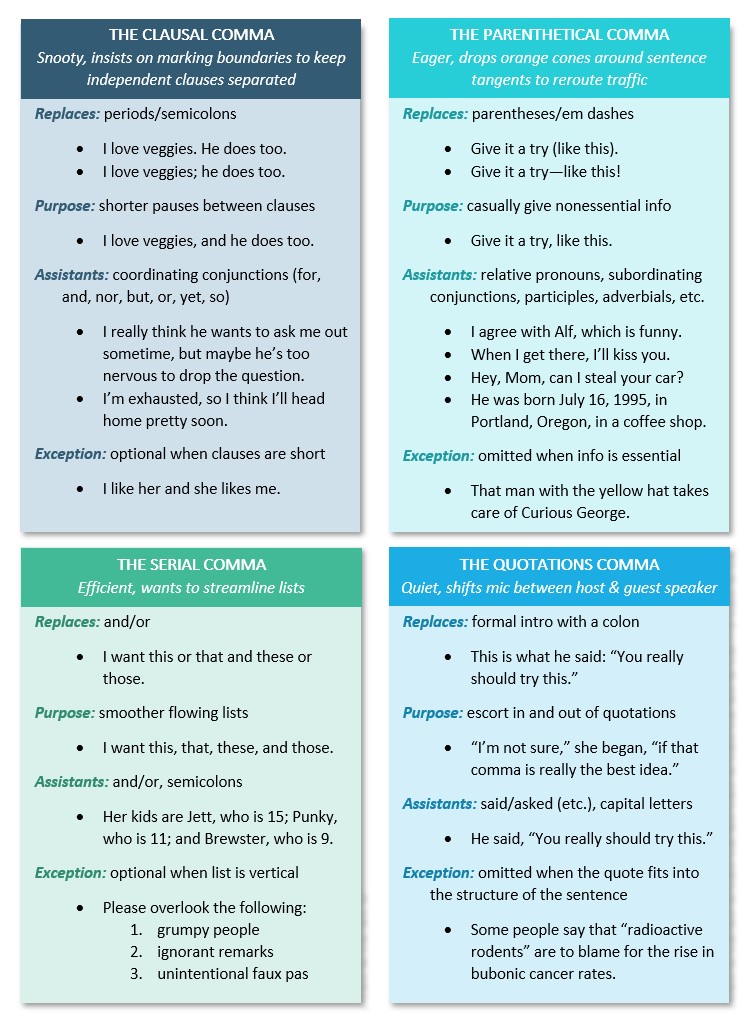30 Punctuation, Memes, and Choice
Nikki Mantyla
- Punctuation Is Powerful
- Periods and Paragraph Breaks Are Preferred
- Semicolons and Colons Like to Link
- Parentheses and Em Dashes Love to Interrupt
- Commas Save Lives
- Conclusion
- Comma Chart
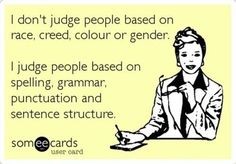
It’s okay to admit that punctuation use is a bit … overwhelming. There’s a lot of pressure knowing that our writing—and by extension, our intelligence—will be judged by our execution of said punctuation, as the meme above so nicely informs us. Even worse, between text messaging, status updates, emails, assignments, and so on, our writing and its punctuation (or lack thereof) is constantly out there for others to see. Insert big gulp.
We might feel like Yoda is talking about us here:
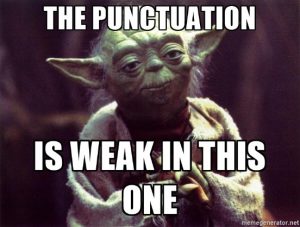
The good news is that we live in the age of social media and its omnipresent, semi-helpful, ever-snarky memes. If we decipher them one by one, we might learn to understand their snide comments and avoid the traps they imply.
LESSON #1: PUNCTUATION IS POWERFUL
Please note that punctuation isn’t as black and white as it is portrayed in some memes. Often there’s a lovely spectrum of available choices, and—as with other writing choices—what punctuation you decide to use affects how your words come across.
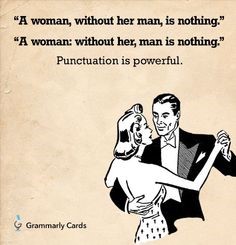
Think about the outrageous line shown in the adjacent meme: “A woman without her man is nothing.” Punctuated one way, it belittles women; the other way, it belittles men. Left without punctuation, it confuses readers of any gender.
(Let me quickly say that I encourage neither gender-damning position—only the analysis of opposing effects.)
This first lesson is fundamental because when we recognize that punctuation is powerful we can anticipate how our markings lead to three possible outcomes: emphasis, de-emphasis, or confusion.
Many of us are already familiar with these effects in verbal conversations. People naturally give each other vocal or body-language signals to emphasize or de-emphasize what they’re saying. They might raise their voice or pause dramatically or make big gestures to convey importance, and they might shrug or snort or roll their eyes to imply something else is unimportant. If their signals are unclear, someone will express confusion: “Wait, what?” Then they’ll try again, slowing down and using a stronger tone so the emphasis isn’t lost this time.
Punctuation allows us to give those crucial cues in writing.
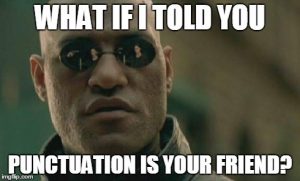
Exclamation points and question marks are obvious examples, but many other written conventions are often overlooked—namely periods, paragraph breaks, semicolons, colons, parentheses, em dashes, and commas. Two of the best ways to stop overlooking them? Notice them and use them. Observe the punctuation in your textbook or your favorite novel (or this article, hint hint). Experiment with punctuation in your school papers and social-media posts and text messages.
Mastering punctuation’s power expands our repertoire for conveying meaning. The broader our repertoire, the more skillfully we can employ the most effective tools for each context. The better our skills, the more our personal style and voice can shine. (And the less the memes will gripe.)
LESSON #2: PERIODS AND PARAGRAPH BREAKS ARE PREFERRED
Isn’t it funny how the most useful things get the least recognition because they’re so ordinary? Periods and paragraph breaks make up the bulk of our conventions arsenal—and for good reason! Imagine if all our sentences ended with exclamation points! Or with question marks? No periods ever? And imagine if all the sentences were shoved together with no paragraph breaks! It would be chaos! Or at the very least, any emphasis would get lost pretty fast! So should we use exclamation points and question marks sparingly? For sure!
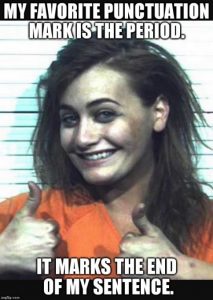
It’s crucial to stress that most of the time the period is where it’s at. A period emphasizes in a different (less shouty) way than an exclamation point. It’s essentially saying “the end” to each concept you describe.
This also means that the longer you take to get to the period, the more emphasis gets lost along the way. Readers pay the most attention to what comes first (“Such an important-looking capital letter!”) and what comes last (“Why did we stop here?”). Structure your sentences accordingly.
Paragraph breaks function the same way but with spacing instead of a mark. The extra space makes it so readers notice your paragraph’s beginning and ending the most. Therefore, the shorter the paragraph, the more it will stand out.
When your sentences or paragraphs go on for too long without any noticeable break in sight, readers start to wonder what point you’re making and why it’s taking so long to make it and how much longer before we can simply move on to the next idea already, since this one has been beaten to death without getting anywhere, other than winding through all the tangents with which you littered the ridiculously long and winding sentence. You run the risk of confusing the reader, and your emphasis is totally lost in the maze of way-too-many-words-and-too-few-stops you just spewed out in one big unorganized blob of utter madness.
It’s better to end your sentences and paragraphs more often to emphasize what you’re saying. Don’t underestimate the power of simplicity.
That said, expectations for sentence length and paragraph size will vary by genre. More research-based, academic-level writing will typically have longer sentences and paragraphs, while writing that’s meant to be digested quickly, like news reports, will stick to short segments. But unless you want to confuse your reader on purpose, avoid labyrinthine sentences and paragraphs in any genre. Get to the point.
LESSON #3: SEMICOLONS AND COLONS LIKE TO LINK
Now that we’ve covered the basics (the stops), it’s time to move into less familiar territory: the middle marks. Punctuation that belongs mid-sentence can make a lot of people start to sweat. But take a deep breath. We have memes here to help, like Ron Burgundy’s assurance:
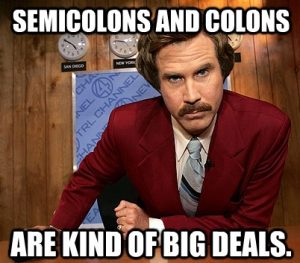
How so? Because semicolons and colons can take the place of a period. You get to where the sentence could end, but then you decide to attach more. It’s a big deal because you get this awesome choice of hooking up your sentence with extra goodness.
Semicolons are the easiest ones, as the meme below demonstrates.
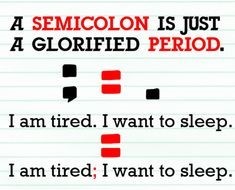
Take two or more sentences; switch the period between them to a semicolon; now you’ve turned multiple sentences into one. That’s it.
The important consideration is why you would want to do that. Semicolons emphasize a connection between the statements. It’s subtle, but it makes the reader consider the reason for the link. Often there’s a compare/contrast situation, as in this case:
Easy, right? Just make sure that each side could stand alone and that the connection is obvious.
What’s cool, too, is that semicolons could fix at least two of the world’s big problems. On a grammatical level, they absolve the blasphemy of unintended comma splices (two statements hitched together with just a comma). Replace the comma with a semicolon and voila!
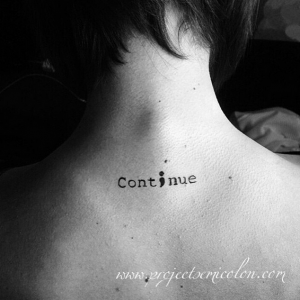
On a more serious level, one group called Project Semicolon began promoting them in April 2013 for a surprising purpose: suicide prevention. The organization says, “A semicolon is used when an author could’ve chosen to end their sentence, but chose not to. The author is you, and the sentence is your life.” Advocates draw or tattoo semicolons on their bodies as a tangible reminder to keep going; don’t end here; there’s still more life to live; continue on …
See? Told you punctuation is powerful.
And now that semicolons make sense, it’ll be easier to understand colons as well. Again, both of them replace a period, but here’s the thing:
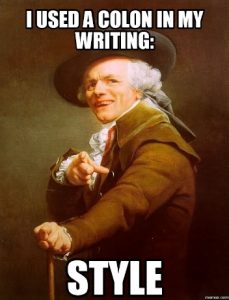
Colons are like a drumroll: they loudly announce (with a big, dramatic pause) that you’re about to provide an explanation hinted at in the preceding statement. You could think of it like this:
Unlike with semicolons, the second part of the sentence doesn’t have to be another full statement. There are lots of choices after a colon: a single word, a list, a quote. In each case, you make a statement suggesting more info to follow, place a colon where you could end with a period, and then deliver on the expectations by providing extra details: like this. It’s the same way a digital clock uses a colon to detail the minutes after stating the hour. Trust me: colons come in handy.
One last option is putting a noun in place of the anticipatory statement. You’re saying, “I’m about to explain this word.” We’re used to this structure thanks to Webster. Conclusion: it’s no big deal.
LESSON #4: PARENTHESES AND EM DASHES LOVE TO INTERRUPT
If punctuation marks had personalities, these two would be the kind of people who butt into the middle of conversations. Parentheses whisper tidbits in your ear; em dashes shout their trivia to the whole room.
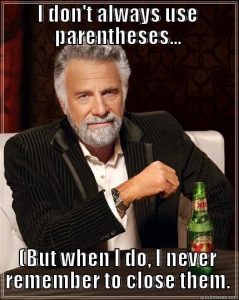
We all know the household rule that any parentheses you open must be closed (unless you’re going for Most Interesting Man in the World, like the neighboring meme). We also know to use them at a logical point in the sentence or paragraph (when our tangent will make sense).
It’s also good to understand that parentheses de-emphasize. You place them around unimportant parts of the sentence that could be completely removed without changing the overall meaning. Anything that is crucial to the sentence should stay outside the parentheses (such as the period on the end). (Unless the whole sentence is in parentheses, like a long whisper.)
Parentheses’ alter egos, em dashes, are more foreign, but it helps to know that parentheses and em dashes are interchangeable. Either set can surround info that is 100% removable. One whispers (de-emphasizes) while the other shouts—emphasis!—and both interrupt an otherwise complete sentence.
Em dashes also have some peculiarities, like their appetite for gobbling up adjacent punctuation that parentheses would have left alone. Notice the mysterious disappearance of the comma in the example below when parentheses are changed to em dashes.
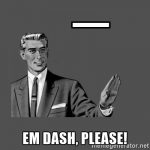
(It’s a fairly recent craving, so if you read older works, like Jane Austen’s, you might notice em dashes and commas getting along just fine. Don’t be confused: punctuation can change!)
Also, em dashes don’t get along with periods at all. But instead of eating the period, the em dash will completely bail when they’re about to meet up. This means we only use one em dash instead of two when the interruption comes at the end.
vs.
Ironically, em dashes—despite all their attention-grabbing qualities—got overlooked by every keyboard maker ever … until the invention of the touchscreen. On a touchscreen, you can hold down a letter/number/mark to see related choices, and that’s where you’ll find our friend the em dash. If you’re on a touchscreen right now, give it a try by holding down the hyphen key on the touchscreen keyboard. See that lengthy option—the really lengthy one? That’s your em dash.
Otherwise, you’ll have to rely on auto-formatting or inserting symbols or using alt codes (PCs) or option + shift + hyphen (Macs) or plain old copy and paste. [See “5 Ways to Create an Em Dash” on Tech Tools for Writers.]
If absolutely necessary, you can place two or three hyphens in a row, but whatever you do, for the love of all that is holy, please never use one hyphen in place of an em dash. Or the memes will bite your fingers off.
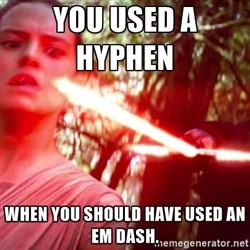
One last thing: em dashes give you a random additional choice brought up by the Futurama meme below—to put a space around them, or not to put a space around them.
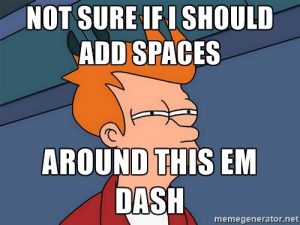
In Microsoft Word, two hyphens with no spaces will automatically format into em dashes as you type, so that’s one legit reason for no spaces. One reason for adding spaces — formatted like this on both sides of each em dash — is that they lengthen the marks, which can be good if your chosen font has somewhat shorter dashes. Other than that, it’s personal preference. Just be consistent (because technically those spaces above are incorrect for this article on the basis that all em dashes in a particular piece should look the same).
Admittedly, em dashes require some practice. It might be good to stop here and give them a try. Maybe text your mom using an em dash on your smartphone—which shows her you’re learning something in college!
LESSON #5: COMMAS SAVE LIVES
It’s time to address the most infamous punctuation meme of all:
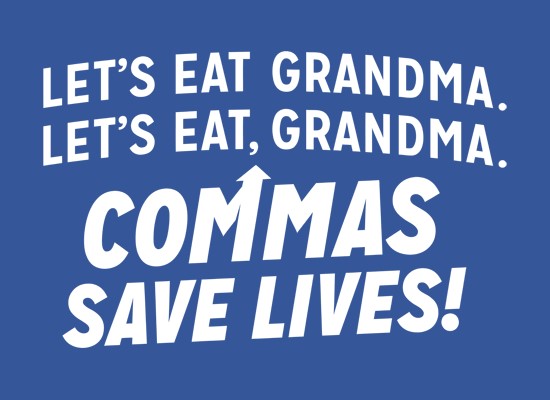
Commas are punctuation heroes in more than one sense. Not only do they save the lives of everyone invited to dinner, they also fill in for a lot of their fellow punctuation marks to give the other guys a break. They’re the ultimate substitutes, ready to jump in at a moment’s notice. They also do their job humbly, de-emphasizing the punctuation’s role in the sentence. We use them when we don’t want to call attention to the structure.
The hardest part is identifying which comma is doing what. They’re like little elves, small and identical and busy-at-work everywhere. At first, it’s tough to tell a clause elf from a parenthetical elf from a series elf from a quotation elf, so they are highlighted below to help you spot them.
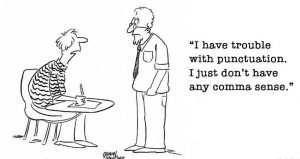
The Clause Comma
A clause comma substitutes for a period or semicolon, yet it needs a buddy. A semicolon implies a connection, but a clause comma spells it out directly using one of its FANBOYS. FANBOYS is an acronym for seven connector words you can choose from, and they are for, and, nor, but, or, yet, so. Comma + connector work as a team, so they’re strong enough to hold two statements together.
The Parenthetical Comma
A parenthetical comma jumps in for (you guessed it!) parentheses or em dashes. Use it when you don’t want to whisper or shout but instead talk in, like, a normal voice. These commas often come in pairs, like twins, the way parentheses do. You could think of them as handles on a tray to lift the removable interruption right out. However, sometimes the removable part will come at the beginning or end, as “however” does here, and then you only need one comma.
The Quotations Comma
A quotation comma can take the place of a formal intro with a colon. Think how stuffy we’d sound if we introduced every quote with a full statement and a colon like a butler with a calling card. Thanks to the quotations comma, we can move in and out of quotations more casually. For example: “I have trouble,” the meme above says, “with punctuation.” The comma pairs with any version of says (asked/joked, etc.) to clarify who is doing the talking.
The Series Comma
A series comma replaces or precedes the word and in a list in order to separate the items. It’s a very organized sort of comma and likes to keep everybody straight. Sounds like a boring job, but it creates more options than you’d think. Notice the meme below, which demonstrates the potential confusion resulting from a missing serial comma.
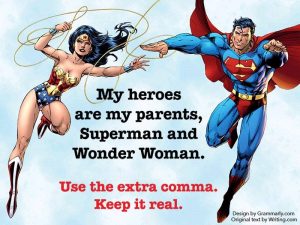
The “extra” comma it needs is called an Oxford comma, which would clarify it’s a list, not a parenthetical description of your parents. But before you condemn those who dismiss the Oxford comma (like Vampire Weekend’s expletive-emphasized song line, “Who gives a [bleep] about an Oxford comma?”), let’s look at how our series-comma choices create various effects.
-
- You could use a series comma + and to emphasize each item:
-
- You could omit all series commas to convey feeling rushed/overwhelmed:
-
- You could alternate between a series comma vs. and to sort out groups:
-
- You could use only series commas to push the emphasis after the list:
Again, isn’t it amazing how much power a little mark can have?
One final series to be aware of is the complex series. It happens when you add details about the items in the list, such as what state each city is in, and the extra commas require semicolons to beef up the separation between the main items, as this meme shows:
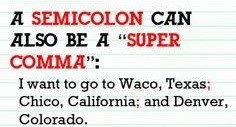
Got it?
If not, don’t be dismayed. It can take a while to tell these little guys apart. You’ll find a printable comma chart below for reference, and it’ll be worth the effort to understand them. Once you know your commas, you won’t have to guess anymore. You can decide where you need them, want them, or can get away without them.
CONCLUSION
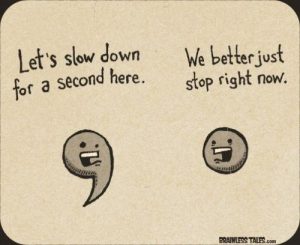
Now, after the several lessons the memes have taught today, the biggest choice that remains is how you will use this knowledge for good and not for evil. Do not troll social media for poor punctuation and lambast the unwitting souls who know no better. Instead, use your powers to create effective messages, effective memes, and effective emphasis. The end.
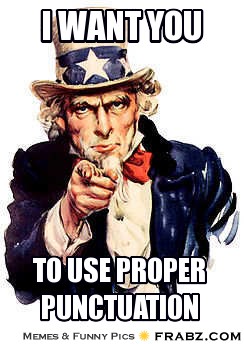
Resources for Further Study
Three great places for further reading on fascinating punctuation power:
- “When Your Punctuation Says It All (!)” by Jessica Bennett, New York Times Feb. 27, 2015
- The Best Punctuation Book, Period. by June Casagrande, 2014
- RealGrammar.com
Comma Chart
Click on either the PDF link or the JPG image below to open and save/print the comma chart for future reference.

